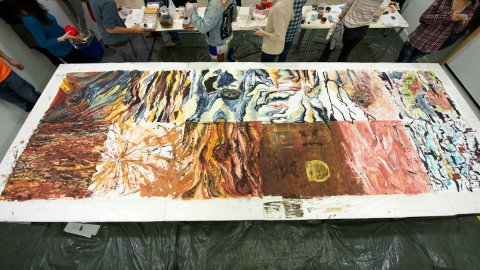HYPOCOERCIVITY AND GEOMETRIC CONDITIONS IN KINETIC THEORY.
Abstract
We shall discuss the problem of the 'trend to equilibrium' for a degenerate kinetic linear Fokker-Planck equation. The linear equation is assumed to be degenerate on a subregion of non-zero Lebesgue measure in the physical space (i.e., the equation is just a transport equation with a Hamiltonian structure in the subregion). We shall give necessary and sufficient geometric condition on the region of degeneracy which guarantees the exponential decay of the semigroup generated by the degenerate kinetic equation towards a global Maxwellian equilibrium in a weighted Hilbert space. The approach is strongly influenced by C. Villani's strategy of 'Hypocoercivity' from Kinetic theory and the 'Bardos-Lebeau-Rauch' geometric condition from Control theory. This is a joint work with Frederic Herau and Clement Mouhot.
The random paraxial wave equation and application to correlation-based imaging
Abstract
We analyze wave propagation in random media in the so-called paraxial regime, which is a special high-frequency regime in which the wave propagates along a privileged axis. We show by multiscale analysis how to reduce the problem to the Ito-Schrodinger stochastic partial differential equation. We also show how to close and solve the moment equations for the random wave field. Based on these results we propose to use correlation-based methods for imaging in complex media and consider two examples: virtual source imaging in seismology and ghost imaging in optics.
Unique Continuation, Carleman Estimates, and Blow-up for Nonlinear Wave Equations
Abstract
In this talk, we consider two disparate questions involving wave equations: (1) how singularities of solutions of subconformal focusing nonlinear wave equations form, and (2) when solutions of (linear and nonlinear) wave equations are determined by their data at infinity. In particular, we will show how tools from solving the second problem - a new family of global nonlinear Carleman estimates - can be used to establish some new results regarding the first question. Previous theorems by Merle and Zaag have established both upper and lower bounds on the local H¹-norm near noncharacteristic blow-up points for subconformal focusing NLW. In our main result, we show that this H¹-norm cannot concentrate along past timelike cones emanating from the blow-up point, i.e., that a significant amount of the action must occur near the corresponding past null cones.
These are joint works with Spyros Alexakis.
The severe European winter of 1962/63
Stability and minimality for a nonlocal variational problem
Abstract
We discuss the local minimality of certain configurations for a nonlocal isoperimetric problem used to model microphase separation in diblock copolymer melts. We show that critical configurations with positive second variation are local minimizers of the nonlocal area functional and, in fact, satisfy a quantitative isoperimetric inequality with respect to sets that are $L^1$-close. As an application, we address the global and local minimality of certain lamellar configurations.




